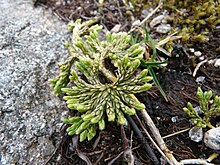Diphasiastrum alpinum
| Diphasiastrum alpinum | |
|---|---|

| |
| Scientific classification | |
| Kingdom: | Plantae |
| Clade: | Tracheophytes |
| Clade: | Lycophytes |
| Class: | Lycopodiopsida |
| Order: | Lycopodiales |
| Family: | Lycopodiaceae |
| Genus: | Diphasiastrum |
| Species: | D. alpinum
|
| Binomial name | |
| Diphasiastrum alpinum | |
| Synonyms[1] | |
|
Synonymy
| |
Diphasiastrum alpinum, the alpine clubmoss, is a species of clubmoss.[2] This plant is a glaucous scale-leaved perennial pteridophyte. In Finland, the spores are produced June to September.[3] It was first described by Carl Linnaeus in his Flora Lapponica, 1737, from specimens obtained in Finland.
Description[edit]
Diphasiastrum alpinum have 30-50 cm long stems, with 3-5 cm long branches. The stems are upright, 4-edged, growing densely in branchy bunches. The leaves are small, scale-like, wintering and parallel to the stem.[3] The leaves are hollow at the bases.[4] The spore-cases are in sesile, 1-1,5 cm long, densely cylindrical spore cones.[3] The female stems produce strobili up to 3 cm (1 in) long.[5][6][7]
Diphasiastrum alpinum may hybridize with Diphasiastrum sitchense.[4]
Distribution[edit]
It has a circumpolar distribution across much of the northern parts of the Northern Hemisphere: much of Canada, the northwestern United States, northern and central Europe, Russia, China and Japan. It is an indicator of alpine tundra and boreal climates.[4] It is found in mountains and moors often with Calluna and grasses.[1][8][9]
References[edit]
- ^ a b "Family Lycopodiaceae, genus Lycopodium; world species list". Archived from the original on 2009-02-27. Retrieved 2015-07-27.
- ^ "Diphasiastrum alpinum". Flora of North America. Retrieved 13 July 2011.
- ^ a b c Piirainen, Mikko; Piirainen, Pirkko; Vainio, Hannele (1999). Kotimaan luonnonkasvit [Native wild plants] (in Finnish). Porvoo, Finland: WSOY. p. 16. ISBN 951-0-23001-4.
- ^ a b c Williams, Tara Y. 1990. Lycopodium alpinum. In: Fire Effects Information System, [Online]. U.S. Department of Agriculture, Forest Service, Rocky Mountain Research Station, Fire Sciences Laboratory.
- ^ Lycopodium alpinum. Washington Burke Museum.
- ^ Flora of North America, Diphasiastrum alpinum (Linnaeus) Holub, 1975. Alpine club-moss, lycopode alpin
- ^ Flora of China, Lycopodium alpinum Linnaeus, 1753. 高山扁枝石松 gao shan bian zhi shi song
- ^ "Species: Diphasiastrum alpinum (Clubmoss, alpine)". NLBIF. Archived from the original on 6 May 2011. Retrieved 13 July 2011.
- ^ Biota of North America Program 2014 state-level distribution map
External links[edit]

